Students, know how you learn then use and abuse it!
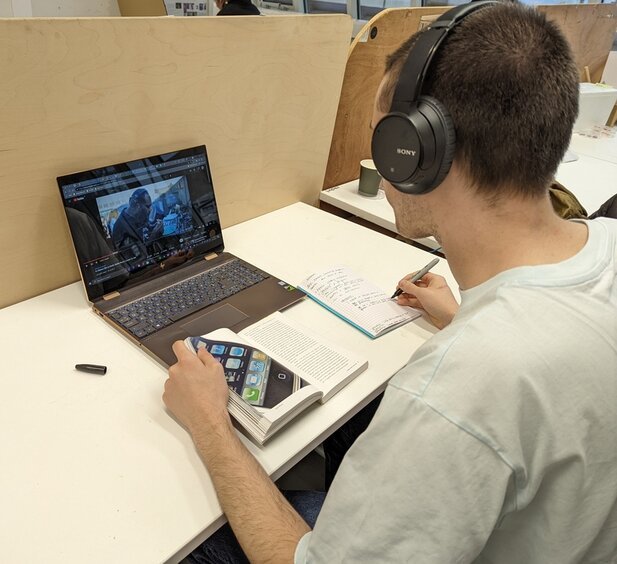
Often when we think about learning, we think about reading textbooks or listening to someone speak about a specific topic. The teaching methods used are the typical visual, auditory, reading or kinaesthetic; VARK for short. Words come up on a board, lecturers reel off information, and, for some, our minds start to wander away from the black and white screen or voice of the lecturer. There are various reasons why an individual may struggle to engage with a singular VARK learning style, and also why it is so important to use a selection of styles. Through various research methods including a case study, the aim of this blog it to enlighten students to the ways in which people learn and that it’s normal to have a preference to certain styles, it may just involve a little bit extra work.Through this piece of writing the credibility of the individual VARK learning methods is questioned and suggested that a mix of all of them has been found to be best. Multimodal learning combines the four modes to engage with those individuals who struggle to grasp information from a singular mode of education. A video with images, subtitles and sound is a good example of multimodal learning, as it engages several senses at one time. Exploring these ideas, this article will discuss the different learning methods, as well as multimodal learning and why this is a far better way of teaching for all. This blog will dissect two of the possible difficulties of this approach to learning; mostly, the generalisation of learning styles, and the societal tendency to link aspects of VARK learning with a particular level of cognitive intelligence.

With University comes a mix of people from around the UK and over the world. Through interviews with students who came to university straight from high school, the topic of how they were prepared for further education and their own knowledge on their own learning style and how enforced this was through school will give a good outlook from someone that has it fresh in their mind. As this student came from a covid era of high school this will also give a unique point of view on how high school worked through the strangest times. Smaller interviews with students in third and fourth year, who all study largely different courses will provide individual insights into how their schools helped them prepare for university and how their course supports all learning styles. My own thoughts on the same topic will be discussed, if I can remember any of it anyway, to provide you with a better understanding of how my brain works and how I discovered this. Through a discussion with a foreign student, the comparison between the Scottish and Luxembourgish schooling systems will open our eyes to the strange and different worlds two countries have in terms of support and teaching. This blog, aimed towards learners will give an analysis of the general knowledge on VARK learning methods amongst university students will be gained, and a look at if students use their preferred learning style or they just trundle through, forcing themselves to learn what, and importantly, how, they must learn to pass their courses and prove they are capable of working in that field. The supply of learning material is continually expanding, with Google in our ears, on our phones and at our fingertips. In the modern western world, the Internet is arguably a vital part of learning, if it is utilised correctly. Some may argue that the appeal of learning from books is dying in our technology rich world, but with technology comes distractions. The underlying position of this blog is that a healthy mix of the different resources for learning is vital to the continuation of improving learning and grades amongst university students. Hopefully the blog will do so in a way that is enjoyable and engaging for all readers so we can keep everyone captivated no matter the preferred learning style.
The Modes
People learn in different ways and often information is taught by using a few select techniques which usually prevents groups of people retaining much of that lesson. VARK is an acronym for the group of learning modes and stands for visual, auditory, reading and kinaesthetic. This was first detailed by Fleming and Mills, who updated the original three letter acronym created by Walter B. Barbe in 1979, of VAK, where reading was included under visual. Fleming thought that reading deserved its own letter as he found many students that he studied had a larger preference for plain writing on a page rather than diagrams or images. Visual learners are more suited to an accumulation of images, graphs, maps, diagrams, the list goes on. VARK Learning Limited states that: “It must be more than mere words in boxes that would be helpful to those who have a Read/write preference”. Auditory learners take information in from verbal lectures, podcasts and discussions, they thrived through covid with online calls, lucky sods. The new letter to the pot was for read/write which differs from visual, as it is word based and lacks images. They prefer books to videos and can take in information from long black and white articles, which is where other learners can struggle massively. Last, but not least, we have kinaesthetic learners who need physical objects to hold. Kinaesthetic learners need the experience of doing a certain task or object to get the most from it, and often struggle to comprehend information when it isn’t in a real physical form
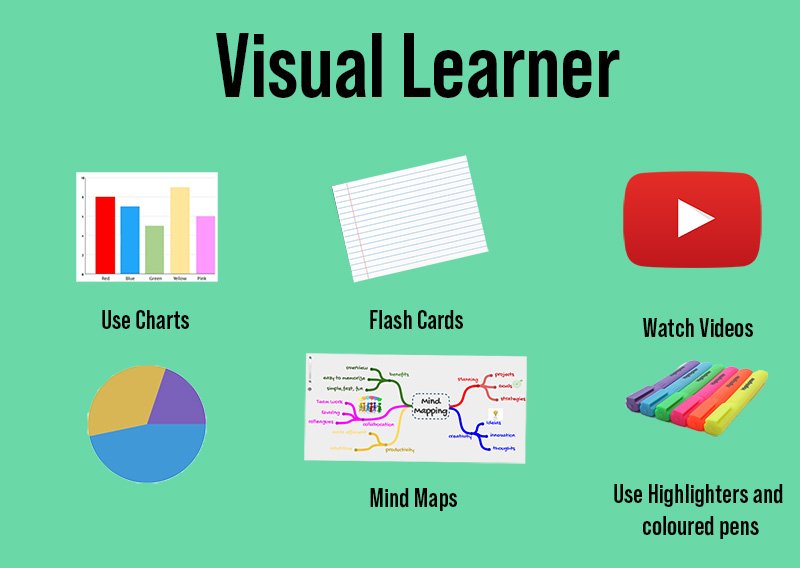
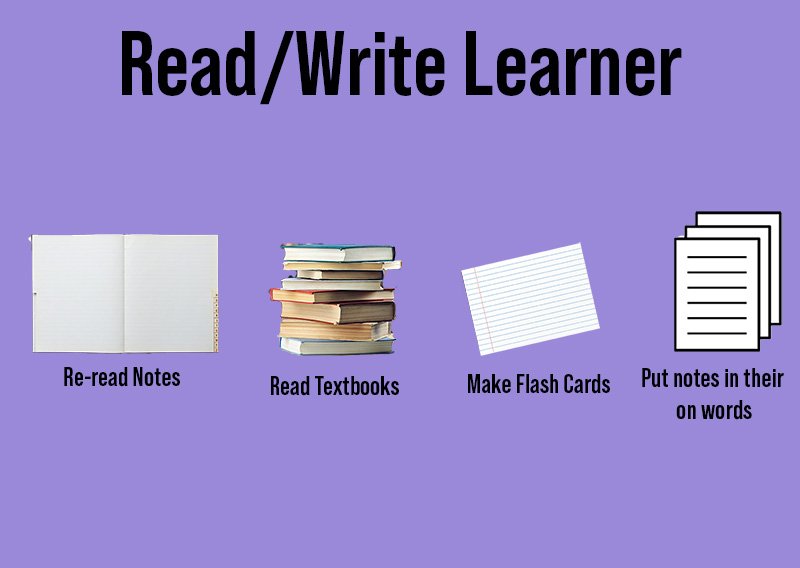
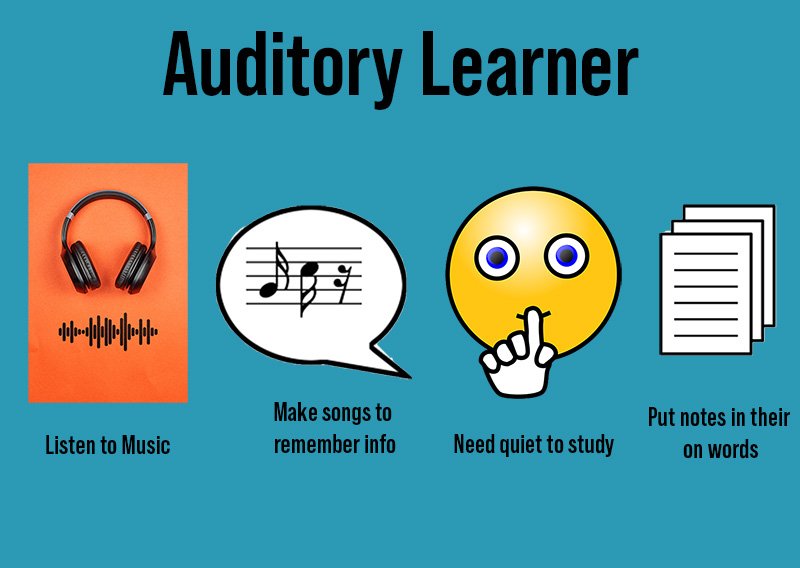
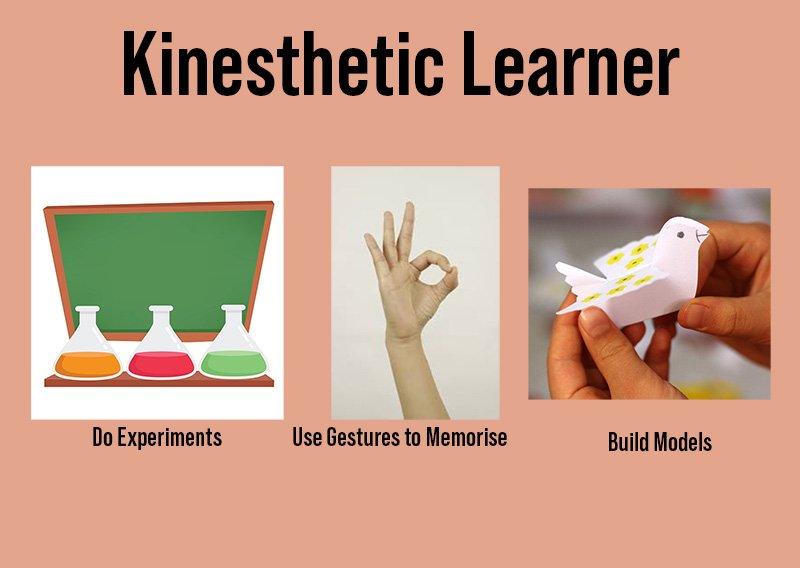
Neil Fleming designed a questionnaire – The VARK Questionnaire- to determine what an individuals’ preferred learning technique is. It asks 16 questions, following similar topics as seen in the image below, with four choices for each question, each answer corresponds to one of the four learning modes. Users can select as many answers that apply. Once the results are up, numbers corresponding to each learning mode, let the user know what their preferred method is or if they are a mix of a few, which is called multimodal. If you want a detailed report on your learning, you’ll have to pay, obviously.
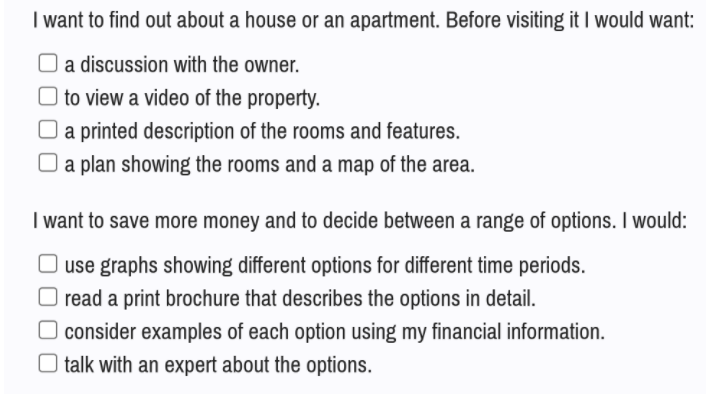
MultiModal Learning
When it comes to learning, the four modes aren’t just clear cut for everyone. Granted, some people will have a huge preference over one or the other, but most will have a mix of two or more. This is where multimodal learning comes in. Defined in two different ways by Vark Learn. The first needs specific contexts and switches learning mode depending on the task at hand. They may prefer to be physically learning how a spring works but need an audio book instead of reading articles. The second multimodal type is for people who need an array of all modes to really understand what it is they are trying to learn. They will need a good understanding of the topic before acting upon it which in the long term could make their decision making far better than the average Joe. Through the VARK questionnaire if two or more of the modes are near equal numbers this would define someone as a multimodal learner.
Time & Effort
When it comes to teaching the different modes, many teachers use multimodal learning as it engages everyone in the classroom and gives students a small bit of each pie rather than a pie only some students will eat. It is easier to utilise multiple modes in certain subjects than it is in others. If you are studying graphic communication the use of images or videos, along with commentary and printouts of text descriptions, are very easy to produce as the subject uses a mix of both written descriptions and images. As well as being a design course, there can be physical aspects to it as well; such as constructing buildings or parts. On the other side of the fence, you have mathematics which is largely reading and writing based. High school and university level maths can get very complicated for some, and the use of images is almost non-existent here; therefore, problematic for those who require visual learning. It can be very time consuming for teachers to include multimodal learning in their classes. For instance, it can be quicker and easier to sit and write out a lump of text for students to read off the board, without having to find, and then explain, relevant images, graphs, experiments. It is no wonder that some students fail their courses when all they get are lectures of someone reading off a board, and then asked to write an essay for it. Subjects need to be as multimodal as they possibly can be. Although it can be time consuming for teachers to provide information in multiple modes, the benefits for the students are potentially massive, and will have a lasting effect on their lives. That is the reason teachers want to be teachers in the first place, right? When learning through multiple modes, students are more likely to retain information for the future, the classroom environment becomes exciting, and morale will be boosted majorly as it is engaging to be there.

Multiple Intelligences
VARK is the most well-known learning style collection but others have built from this and provide other versions. One theory is Multiple Intelligence by Howard Gardner who proposes a nine intelligence system with a much deeper process into understanding how people learn than VARK. These nine are; Verbal-linguistic, Logical-mathematical, Spatial-visual, Bodily-kinesthetic, Musical, Interpersonal, Intrapersonal, Naturalist, and Existential. Gardner proposes that everyone has the capacity to understand learning through all nine variations in one way or another. It is important for knowledge to be taught and presented in a way that benefits everyone, in doing so humanity will become far smarter. Gardner goes on to say that teaching material in multiple ways not only helps the students understand but solidifies the knowledge of the teacher. Multimodal learning in Gardners mind is the best and only way for the next generation of humanity to improve. Gardner’s nine intelligence theory is not only deeper than Flemings’ VARK but is different from the ‘learning styles’ category he often gets placed in. He mentions:
“Style refers to the customary way in which an individual approaches a range of materials—for example, a playful or a planful style. Intelligence refers to the computational power of a mental system: for example, a person whose linguistic intelligence is strong is able readily to compute information that involves Language.” (Gardner, 2013)
This means the way someone goes about learning something is a style but how a person’s brain is wired and rewired to learn and present certain studies is intelligence. Another example Gardner uses is music, although a person can enjoy music it is totally different from being musically intelligent.

Take a break!
That was a lot of reading!
My Own Story
How Students Dealt With Their Own Learning Style
Although my opinion is taken in high regard, it’s always nice to hear from others, so I spoke to a few people who are at university but all do varying courses. Speaking to them individually it became apparent the opposing thoughts and feelings they had, changing from school to school. One recurring point though, was the support they received in high school for their learning styles. It was either no support at all or done as a class, there doesn’t seem to have been any focus on each individual student to see if they need to be supported further. More often than not in school, teaching is done in a very linear way, students often just write out notes, repeating what the powerpoint says, writing it down in a notebook. This method works for some people but it really doesn’t work for visual or kinesthetic learners leaving them behind and causing them to find their own way of learning the same information others get fed to them. One student I talked to said “High school work didn’t necessarily suit my learning style”. He goes on to say that it took until being in a university environment for him to see what his learning style was and how he can utilise this for longer writing tasks. During his high school years, “work that would nowadays cause me minimal stress at times became difficult and hard to manage”. If teachers looked at students in unique ways, it might have made Bradley aware that there are other ways of doing the planning stage and therefore relieved him of some stress. The only preparation for university through high school was Advanced Highers which started to incorporate a more academic style into the courses which would be used in Uni. The other bit of preparation was the free periods students had in the final year which simulated the idea of working in your own time and having space between classes. Although, my free periods were used for playing Poker and having a laugh, so I won’t provide my opinion on this question.
One of the questions I asked the students was, what could lecturers do to improve their teaching so that all learning styles get accounted for, and similar themes came up, multimodal! A push for more visuals in the powerpoints, supporting video links and other media to help build the strength of the information as well as support other learning styles. The gain from using visuals like diagrams and flowcharts in the powerpoints would help keep engagement up in the lecture as we all know how mind numbing it can be just having someone read off the screen. We don’t need a 9am lecture for something we can read in bed at our own time. There was also a positive point made that lectures are changing by using online quiz websites such as mentimeter which allow for students to answer questions from their phone without the need to speak in front of two hundred people, or have three voices start chatting over one another in a Teams call. There are positives to the techniques lecturers are using, but they all involve technology which we will get to shortly.
How First Year Students Managed Through Covid
As well as speaking to some third and fourth year Uni students, I also spoke to a couple of first year law students who gave me an insight into what it was like going through their last year of high school with COVID going on. Both of them mentioned how there was next to no preparation for further education due to the disruption of teaching and having to do everything through Teams. It took away any connection they would have in normal times with their teacher and became quite impersonal. I can’t imagine what it must have been like making a big life step such as moving to Uni without being able to see anyone physically. Part of me is glad that it was the third year I had to go through with covid rather than my last year in high school.
The Strange System Of Luxembourg
When it comes to schooling, I know my own experience of high school and the ways our teachers would try to focus our learning styles but as this is majorly based on University, I don’t know anything about foreign schooling systems and how they prepare students for higher education. This is where my friend Ella comes in, having grown up in Luxembourg, a country of just over 600,000 people the way high school works there is very different from Scottish schools and quite flawed in a way as well. Ella, who studies product design, spent her whole lower education in Luxembourg going through the system and was kind enough to give me her experience of it. She started off by explaining how they pick their subject group at the age of 15, which seems very young considering how much teenagers develop between 15 and 17 years old. Ella also said that there isn’t really any way of changing later down the line without having to resit a year. In the school they have different academic groupings, Ella was in the classic group which was the standard academic subjects, all being taught in German except French and Maths as they want to push you into knowing other languages so you can study in different countries. This was the mainstream for a lot of students at her school but her on personal experience was a bit different as she did the international baccalaureate which was to prepare her for international school and so she did standard grades and highers, it also allowed her to avoid learning all the subjects in French as french was one of the subjects.
When it comes to support for individual learning styles, Ella mentions it was quite lacking, as she was part of the classic academic group, it heavily relied on reading, writing and auditory, there wasn’t much input for the visual and kinesthetic styles. Luckily for her this suited her learning style and so she didnt really have a problem with it. But the downside of this for her is that in product design at university, she often sticks to what she knows and writes her ideas down instead of sketching them out as we should. If a student wanted to do art or music it was a very harsh place for them to thrive as the support for those subjects just wasnt there at all. “There’s about two schools in Luxembourg that even offer it or only a handful of schools are after the music section” she mentions when talking about the choices people made at 15 years old. Ella also says because Luxembourg is driven by profit they really push people to go into law, medicine and engineering with the rest put to the back of their mind.
Technologies Part In Teaching
As technology progresses and the need for the internet for extra information increases, the use of this in school also progresses. Rather than having to put your hand up to answer the question or being chosen at random to answer something when you are too nervous to say anything in front of the class, students now get given an ipad each or use their phone to anonymously answer the question with a funny name attached. How is technology improving the classroom experience? The ability to quickly search up a word they dont understand or search images for a diagram explaining the lesson that the teacher roughly skipped over is a massive improvement in the overall way teaching is done. Going back to the point of time and effort, effort can be saved in classes if the presence and acceptance of technology is allowed within all studies, if managed well of course as with technology, comes distractions. Effort saved is time saved which perhaps opens up the class for deeper talks with specific students.



